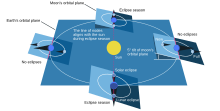

The full moon is the lunar phase when the Moon appears fully illuminated from Earth's perspective. This occurs when Earth is located between the Sun and the Moon (when the ecliptic longitudes of the Sun and Moon differ by 180°).[3] This means that the lunar hemisphere facing Earth—the near side—is completely sunlit and appears as an approximately circular disk. The full moon occurs roughly once a month.
The time interval between a full moon and the next repetition of the same phase, a synodic month, averages about 29.53 days. Because of irregularities in the moon's orbit, the new and full moons may fall up to thirteen hours either side of their mean. If the calendar date is not locally determined through observation of the new moon at the beginning of the month there is the potential for a further twelve hours difference depending on the time zone. Potential discrepancies also arise from whether the calendar day is considered to begin in the evening or at midnight. It is normal for the full moon to fall on the fourteenth or the fifteenth of the month according to whether the start of the month is reckoned from the appearance of the new moon or from the conjunction.[4] A tabular lunar calendar will also exhibit variations depending on the intercalation system used. Because a calendar month consists of a whole number of days, a month in a lunar calendar may be either 29 or 30 days long.
- ^ "'Super Moon' ExceptIonal Brightest Moon in the Sky of Normandy, Monday, November 14". silvertimes.com. 12 November 2016. Archived from the original on 27 April 2020. Retrieved 8 February 2017.
- ^ "Supermoons". NASA Science. Retrieved 2024-07-14.
- ^ [P. Kenneth Seidelmann (ed.), "Phases of the Moon", Explanatory Supplement to the Astronomical Almanac: A Revision to the Explanatory Supplement to the Astronomical Ephemeris and the American Ephemeris and Nautical Almanac, (Mill Valley: University Science Books, 1992), p. 478.
- ^ "意外と違う満月の日と十五夜の日(満月の月齢変化) (No.0534)".